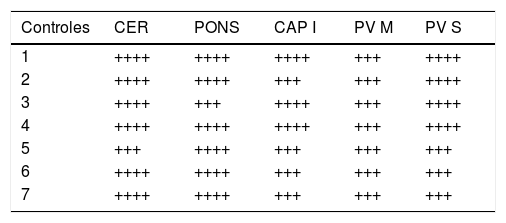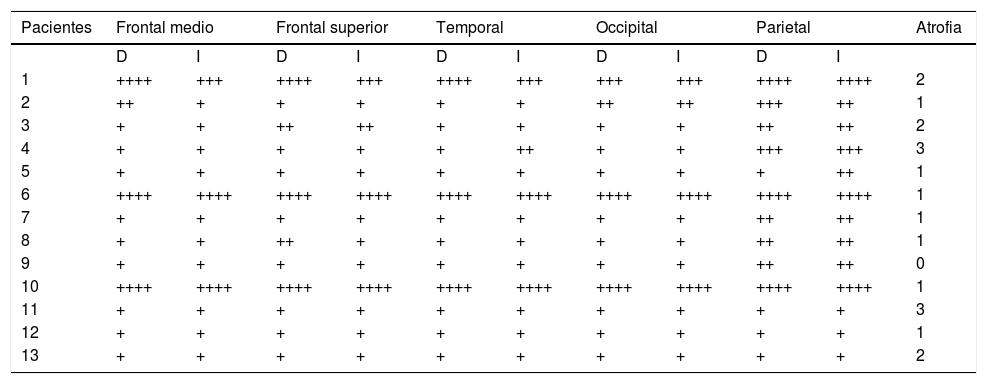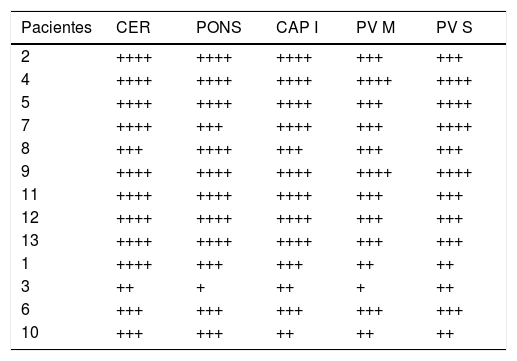El depósito cortical de amiloide, una seña de identidad de la enfermedad de Alzheimer, se ha observado en la hidrocefalia a presión normal (HPN). Nuestro objetivo fue comparar el patrón de retención de 11C-PIB PET/TC en pacientes con HPN y sujetos sanos.
Material y métodosHemos comparado el patrón de retención de 11C-PIB en 13 casos de HPN seleccionados para cirugía derivativa con una población control normal. Las imágenes se analizaron visualmente y puntuaron de 1-4 (de ligera a muy alta retención de PIB) tanto en la sustancia gris como en la sustancia blanca (SB). La puntuación se analizó por separado en las regiones infra y supratentoriales de ambos grupos. Se emitió un informe clínico en términos de positivo, negativo o dudoso/equívoco.
ResultadosOcho 11C-PIB PET/TC se informaron como negativos, 3 positivos y 2 dudosos. Cinco de 13 pacientes mostraron al menos una región cortical con retención de PIB de intensidad mayor que la observada en el grupo control. En general, la retención de PIB en la SB de los pacientes con HPN tuvo puntuaciones menores que en el grupo control, mostrando una diferencia estadísticamente significativa en la SB infratentorial (92/104 vs. 54/56, p<0,05) y una tendencia a ser menor en las regiones supratentoriales (70/84 vs. 122/156; p=0,327), en particular en la región periventricular superior (25/28 vs. 40/52; p=0,134).
ConclusionesLos patrones de retención de 11C-PIB parecen ser diferentes en los pacientes con HPN comparados con sujetos normales. La retención de PIB en la SB de la HPN aparece menos intensa que en sujetos sanos y estos muestran un mayor grado de retención de PIB en las regiones corticales. Esto merece ser tomado en consideración.
Cortical cerebral amyloid disease, a hallmark of Alzheimer's disease, has also been observed in idiopathic normal pressure hydrocephalus (iNPH). The aim of this study was to compare the 11C-PIB PET/CT retention pattern in iNPH patients and healthy subjects.
Material and methodsA comparison was made of the 11C-PIB PET/CT retention pattern in 13 iNPH patients selected for surgical deviation, compared to a normal control population. Images were visually analyzed and scored for gray matter and white matter (WM) from 1 to 4 (slight to very high PIB retention). The scoring was analyzed in both groups separately for infra- and supra-tentorial regions. A comprehensive clinical report was presented in terms of positive, negative, or equivocal.
Results11C-PIB PET/CT scan were reported as negative in 8, positive in 3, and equivocal in 2. Five of 13 patients showed at least one cortical area with PIB retention with an intensity higher than that observed in the control group. Overall, white matter (WM) PIB retention of iNPH scored lower than in the control group, showing a statistically significant difference in the infratentorial WM (92/104 vs 54/56; p<.05) and a tendency to be lower in the supratentorial regions (70/84 vs 122/156, p=.327), in particular in the upper periventricular region (25/28 vs 40/52; p=.134).
ConclusionsThe PIB retention pattern seems to be different in NPH, compared to normal subjects. PIB retention in WM of NPH appears less intense than in healthy subjects, and they show a higher degree of PIB retention in cortical regions. This deserves to be taken it into account.
Article
If you experience access problems, you can contact the SEMNIM Technical Secretariat by email at secretaria.tecnica@semnim.es or by phone at +34 619 594 780.

Revista Española de Medicina Nuclear e Imagen Molecular (English Edition)











